#grassland arthropods
Photo
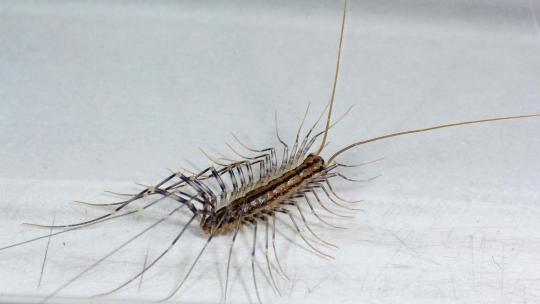
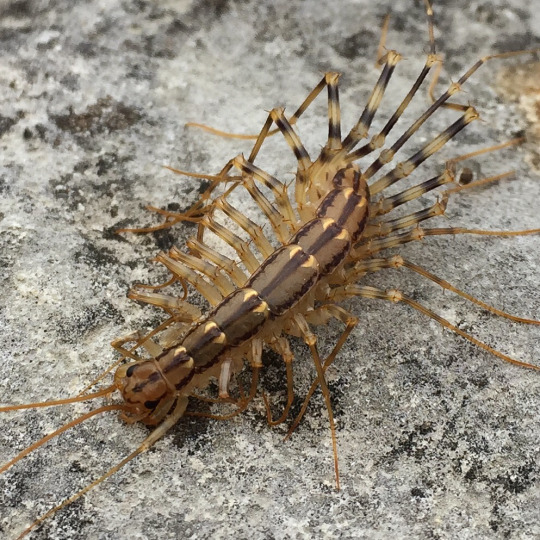
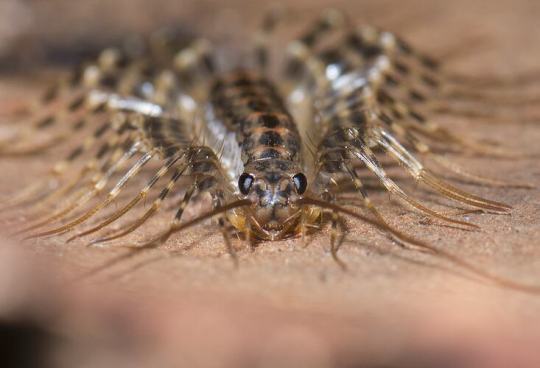
Open Your Home to the Common House Centipede
A common sight in homes throughout Europe, Asia, the Americas, and Australia the common house centipede (Scutigera coleoptrata) is a medium-sized species of centipede originally from the Mediterranean. In the wild, they prefer grasslands and deciduous forests where they can hide under rocks, logs, or leaf litter. These insects have also adapted well to urban development, and are frequently found in basements, bathrooms, and garages, as well as gardens and compost piles.
Like other centipedes, the common house centipede has less than 100 legs; in fact, they only have 15 pairs, with the front pair used only for holding prey or fending off threats. All those legs let the common house centipede move up to 0.4 meters per second (1.3 ft/s) over a variety of surfaces, including walls and ceilings. The actual body of S. coleoptrata is only 25 to 35 mm (1.0 to 1.4 in) long, but the antennae are often as long as the body which can give this insect a much larger appearance. However, they can be hard to spot, especially in their natural environments; their tan and dark brown coloration allows them to blend in seamlessly to surrounding vegetation.
Though they pose little threat to humans, house centipedes are predatory. Their primary food source is other arthropods, including cockroaches, silverfish, bed bugs, ticks, ants, and insect larvae. S. coleoptrata is a nocturnal hunter, and uses its long antennae to track scents and tactile information. Their compound eyes, unusual for centipede species, can distinguish daylight and ultraviolet light but is generally used as a secondary sensory organ. When they do find prey, house centipedes inject a venom which can be lethal in smaller organisms, but is largely harmless to larger animals. This makes them important pest controllers. In the wild, house centipedes are the common prey of rodents, amphibians, birds, and other insects.
The mating season for S. coleoptrata begins in the spring, when males and females release pheromones that they can use to find each other. Once located, the male spins a silk pad in which he places his sperm for the female to collect. She then lays fertilized eggs in warm, moist soil in clutches of 60-150. These eggs incubate for about a month, and the young emerge with only four pairs of legs. Over the next three years, juvenile house centipedes molt 7 times, each time gaining new pairs of legs. After they grow their last pair of legs, immature house centipedes molt an additional 3 times, at which time they become sexually mature. If they can avoid predation, individuals can live up to 7 years in the wild.
Conservation status: The common house centipede has not been evaluated by the IUCN, as it is relatively common both in the wild and in urban areas. Although they have been introduced to areas outside their native range, no detrimental environmental effects have been associated with their spread.
If you like what I do, consider leaving a tip or buying me a ko-fi!
Photos
Joseph Berger
David Paul
Conrad Altman via iNaturalist
#common house centipede#Scutigeromorpha#Scutigeridae#centipedes#myriapoda#myriapods#insects#arthropods#deciduous forests#deciduous forest arthropods#grasslands#grassland arthropods#urban fauna#urban arthropods#europe#north america#south america#asia#australia#oceania#animal facts#zoology#biology
621 notes
·
View notes
Text

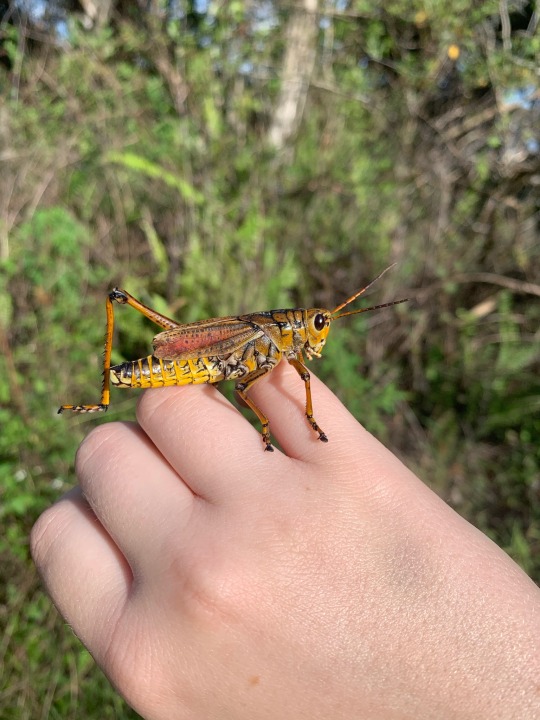

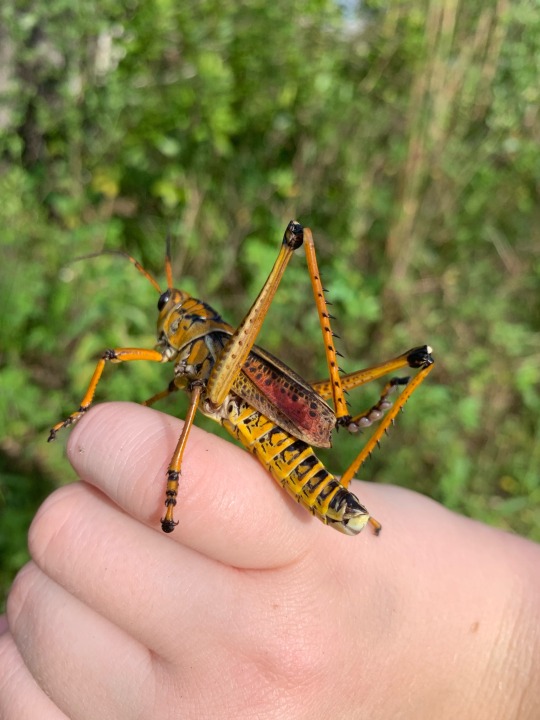
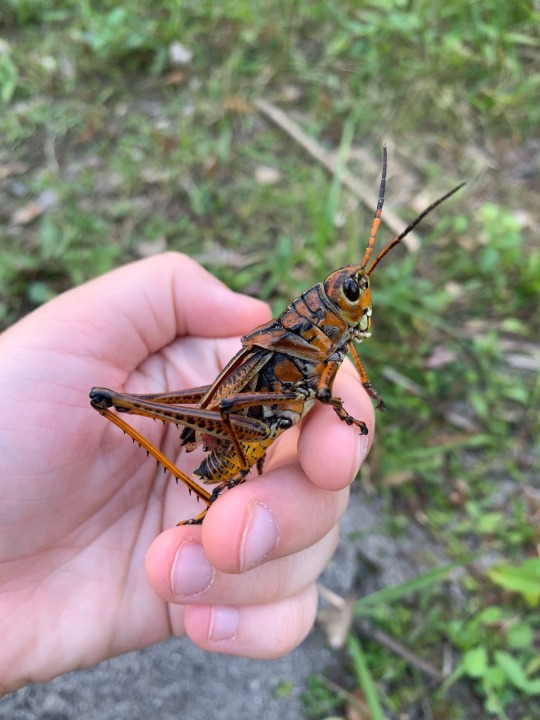
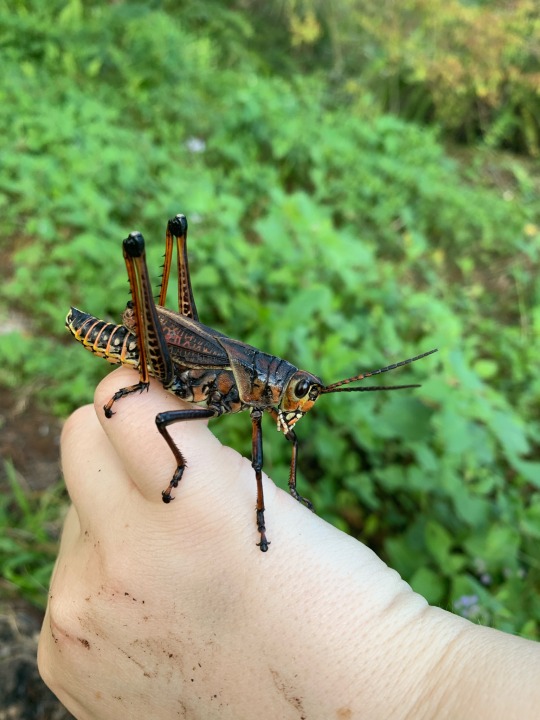


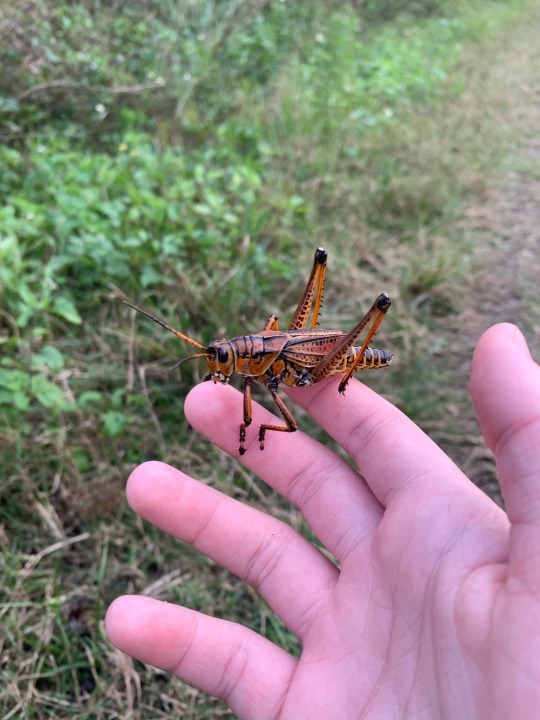
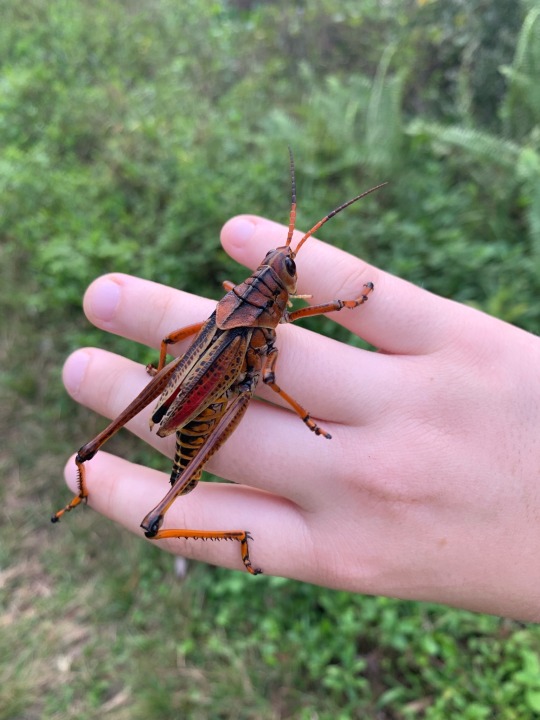
every single photo is an individual
from a trail I went on a couple days ago
#nature#nature photography#photography#pretty forest#grassland#grasslands#nature photos#nature pics#natural world#unedited photos#florida#bugs#insects#entomology#eastern lubber grasshopper#lubber grasshopper#grasshopper#arthropods
45 notes
·
View notes
Text

Instead of starting a whole new speculative biology project like I tend to do, I decided to continue one I already have. The one I selected is my Pangea Ultima project which speculates life on Earth 250 million years from now when all the continents have reformed into a super continent like they did 250 million years ago. Where I left off on this project I was exploring the grasslands/plains on Pangea Ultima and in this post I'll showcase the (comparatively) smaller herbivores of this environment.
Plains Loper: Large descendants of crickets reaching 17 in in total body length, the Plains Lopers evolved elongated heads for reaching grasses as the wildebeest and antelope of the distant past have. Their exoskeletons have become beetle-like to provide some protection from predators but will use their powerful hind legs to escape danger.
Grass Roach: Rivaling the largest roaches of today (at 4 in.), the Grass Roach evolved extra long legs positioned below there bodies to achieve great speeds and coloration that helps them blend in with the grasses that they feed on.
Armadillopod: Giant descendants of isopods (aka pill bugs/roly-polies), these heavily armored scavengers feed on decaying plant matter, roots, and even carcases left behind by predators. If they feel threatened they will partially submerge themselves in the ground using their hook-like legs and barbed rim of their shells to hold themselves in place leaving only their remarkably durable shells exposed.
Prairie Ashbreather: Filling the ecological niche once filled by long extinct gophers and prairie dogs, the Prairie Ashbreathers dig elaborate tunnels below the grasslands with powerful claws feeding primarily on root systems though they will occasionally snag a Grass Roach if it's able to catch one.
As always, comments and critiques are welcome.
#speculative biology#speculative evolution#speculative zoology#ecology#creature design#insect#arthropods#isopods#roach#cockroach#mammals#mammal#rodent#pangea ultima#my art#digital color#digital illustration#digital art#grasslands#prairie#plains#grass#future evolution
13 notes
·
View notes
Text
I've been doing a lot of volunteer fieldwork with these guys recently so I thought I might as well do an infodump about them here.
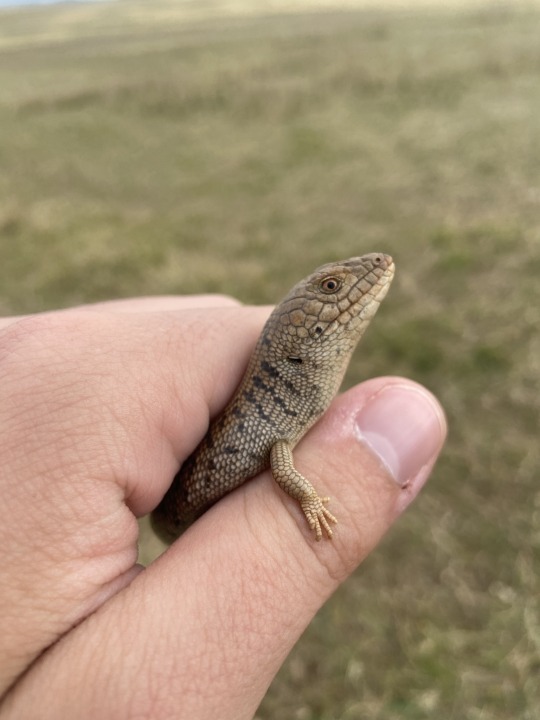
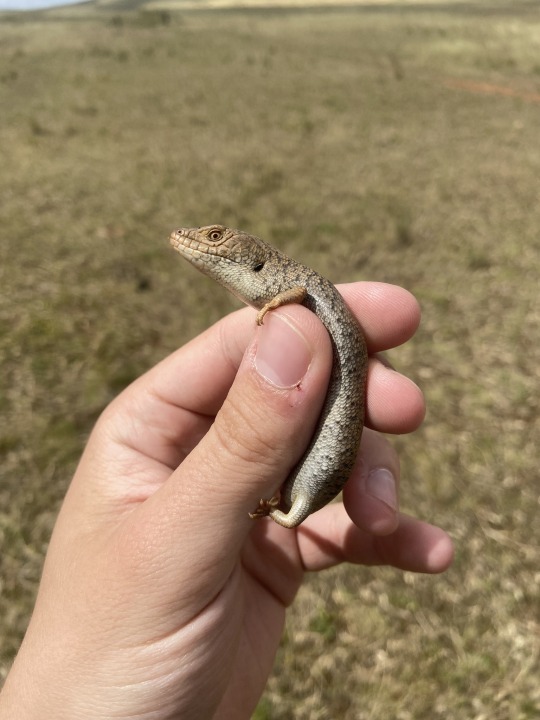
The pygmy bluetongue skink (Tiliqua adelaidensis) is one of the most unique and unusual members of the Tiliqua genus, which includes the true bluetongues as well as the sleepy lizard/shingleback. However, the pygmy bluetongue actually lacks the blue tongue the group is named after, having a pink tongue instead! As its scientific name suggests, it is quite a range restricted species, being found only in open grasslands north of Adelaide, South Australia, as far north as Peterborough. Historically they ranged more extensively across the Adelaide Plains, as far south as Marion, but due to the destruction of suitable habitat they now occur no further south than Kapunda.
While most bluetongues are notable for their large size amongst skinks, with several species regularly exceeding 30 cm in length, the pygmy bluey lives up to its name by measuring a measly average of 9 cm long from snout to vent. This is actually still a fair size compared to the average skink, but it's miniscule by bluetongue standards. Even more notable than their size however are their habits, for they are the only species of lizard that is specialised to live exclusively in old spider burrows! The burrows of both trapdoor and wolf spiders are used, but trapdoor burrows are preferred in most instances.

Pygmy bluetongues spend the majority of their lives within these spider burrows, leaving only to defecate, seek out mates and disperse. The average length of time a lizard spends in a particular burrow is highly dependant on the individual - some are sedentary and spend many years within a single burrow, while others will move around fairly frequently. As well as places to shelter and raise their young (they have parental care, it's very cute), pygmy bluetongues also use the burrows as ambush sites, waiting at the top for suitable prey, usually a mid-sized arthropod, to stray close enough for them to quickly dart out and drag them into the depths.
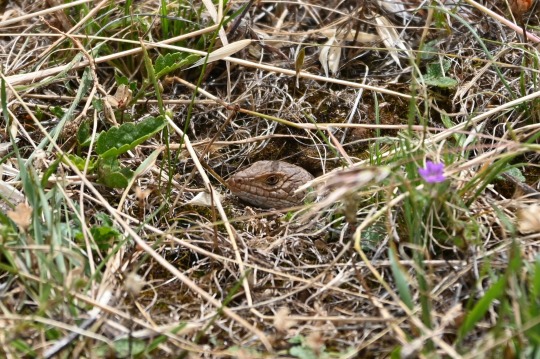
but here's the ambusher
The chief natural predators of pygmy bluetongues are raptors and brown snakes, and sheltering in the burrow is the main defence against both of these threats. Their burrows are often wide enough for a brown snake to enter, but not wide enough for them to open their mouths in - this means all the brown snake usually gets by pursuing a sheltering pygmy is an angry lizard attacking its face, forcing it to retreat.
The lazy lifestyle of the burrow-stealing pygmy bluetongues is certainly unique, and also explains why they have been such an elusive species since they were first discovered by Western scientists in the 1860s. Rarely seen or collected, their habit of inhabiting spider burrows remained undiscovered for the longest time, and by the 1960s they had become so hard to find that they were believed to be extinct. That was until, in 1992, a pygmy bluetongue was found inside the stomach of a roadkill brown snake by amateur herpetologist Graham Armstrong, confirming their status as a Lazarus of the lizard world.
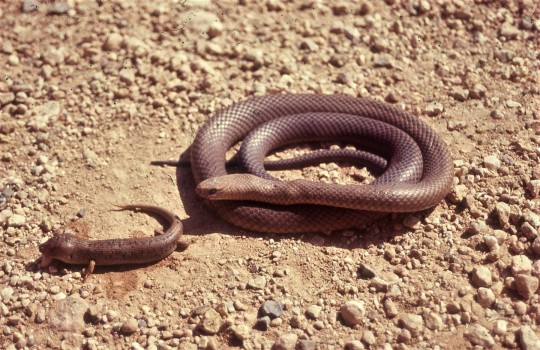
The historic rediscovery of the pygmy bluetongue
(Image credit: Graham Armstrong)
Our previous assumptions of extinction were fortunately premature, but the pygmy bluetongue skink is in serious trouble nonetheless. While they are able to live in a variety of different grassland types, both native and exotic, the extensive modification of their entire distribution through cereal cropping and urbanisation has led to their populations becoming very small and fragmented, giving them a ranking of Endangered on the IUCN Red List. Almost all of these populations are on private land (often grazed by sheep), which makes protecting and/or studying them particularly difficult and complex.
However, when it comes to future threats to the species, climate change is easily the most worrying. As Australia becomes ever hotter and drier, their small remaining distribution is likely to become largely unsuitable, threatening the existence of the entire species. To combat this, researchers are currently investigating the viability of translocating populations further south to areas with cooler climates, providing a safeguard if they do indeed disappear from their remaining natural distribution.
But how do you study a lizard that lives exclusively in small spider holes? Well, if you want to catch them, there's only one tool for the job - the humble fishing rod. Not any special fishing rod either, just a regular rod with a poor mealworm shoddily tied to the end. Using this, you can engage in a tug of war with the lizards until, if they aren't being too difficult, you're able to pull them completely out of their burrow and catch them to perform the necessary measurements and processing. David Attenborough kindly demonstrates this technique in Life in Cold Blood, although in his case the lizard was steadfast in remaining in the burrow!

the sacred tool of the mighty lizard fishermen
returned to their abode
Two additional Fun Pygmy Facts:
Fun Pygmy Fact #1 - The closest living relative of the pygmy bluetongue is the sleepy lizard!
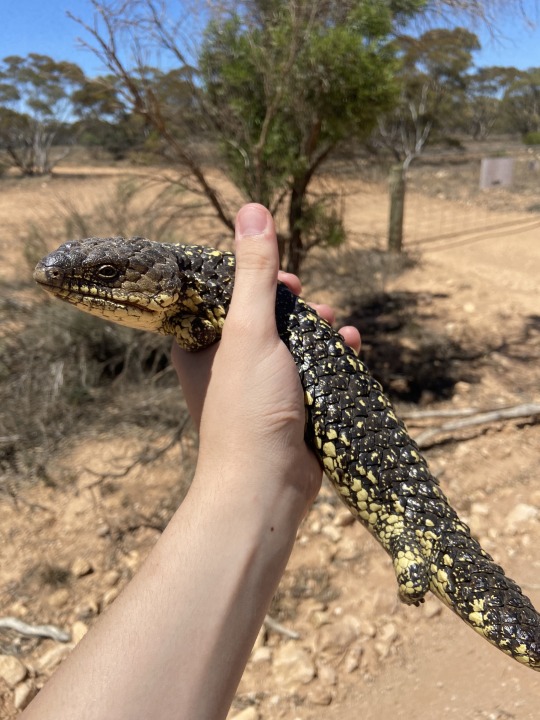
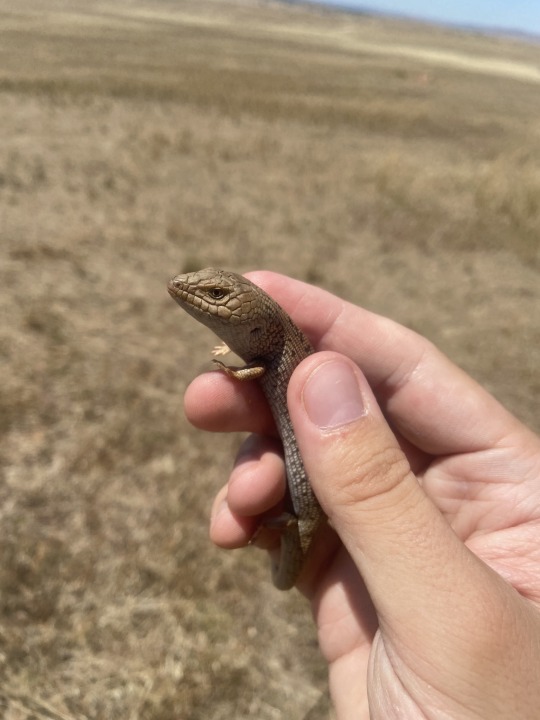
cousins!
Fun Pygmy Fact #2 - Wooden artificial burrows purpose-made for pygmy blueys have proven effective, and the lizards inhabiting them even tend to be in better body condition than those in natural burrows!

#australian wildife#wildlife#reptile#lizard#skink#tiliqua#bluetongue#animal facts#herpetology#natural history#fieldwork#infodumps#my stuff
856 notes
·
View notes
Text

Bloody-Nosed Beetle (Timarcha tenebricosa)
Family: Leaf Beetle Family (Chrysomelidae)
IUCN Conservation Status: Unassessed
Also known as the Blood-Spewing Beetle, the Bloody-Nosed Beetle is a large, wingless, herbivorous species of beetle named for its unusual defensive adaptations: when threatened, members of this species secrete a thick, blood-red liquid from their mouths, giving the impression that they are experiencing a heavy nosebleed. The “blood” secreted by Bloody-Nosed Beetles is actually haemolypmh (a typically transparent bodily fluid found in the circulatory system of most arthropods which serves the role of both the blood and lymph of vertebrates) which contains both haemoglobin (giving it its striking red colour and allowing for more efficient oxygen transportation while in the body) and numerous foul-tasting chemicals that make the beetle unpalatable to most animals, deterring the majority of predators and causing hesitation even in those that are not deterred by the taste. Fairly common in grasslands, heathlands and other densely-vegetated habitats across much of Europe, adults of this species are slow-moving and active mainly at night, using their strong, hook-tipped legs to climb through dense vegetation and relying on their long, segmented antennae to aid them in finding bedstraws (small, often hairy plants in the genus Galium,) which they feed on exclusively. Adults lay their eggs on or near bedstraws to ensure their offspring have access to food after hatching, and while they are unable to survive the low temperatures of their range’s winter their larvae (which are jet-black with short antennae and rotund, wrinkly-looking bodies) burrow underground to pupate as the temperatures get lower, emerging as adults in the following spring.
--------------------------------------------------------------------------
Image Source: https://www.inaturalist.org/taxa/118838-Timarcha-tenebricosa
#bloody-nosed beetle#beetle#beetles#zoology#biology#entomology#animal#animals#insect#insects#arthropods#arthropod#European wildlife#invertebrates#wildlife
275 notes
·
View notes
Text
February 12th, 2024


Giant Whip Scorpion (Mastigoproctus giganteus)
Distribution: Found in the southwestern United States, including New Mexico, Arizona, Oklahoma and Texas, down through much of Mexico, as well as Florida.
Habitat: Found in arid habitats; deserts, scrub forests and grasslands, where they take shelter beneath plant debris, in rock crevices or in abandoned animal burrows. Can be found living at altitudes of up to 6000 metres.
Diet: Carnivorous; feeds on a variety of invertebrates, including cockroaches, crickets, millipedes, other arachnids, worms and slugs. Has also been documented feeding on small toads and frogs.
Description: Though their name would suggest otherwise, giant whip scorpions are more closely related to spiders than they are to true scorpions. This species is also referred to as the giant vinegaroon, as it has the capacity to spray a substance containing high concentrations of acetic acid, the same acid found in vinegar. They're able to spray up to 19 times in a row before their pygidial gland is depleted (though it fills up pretty fast; they're usually ready to go again the very next day!). This spray does not usually cause long-term harm, but can occasionally cause the skin to blister, as well as intense pain if it gets into the eyes. Luckily, they only spray when touched—as long as you remain at a respectful distance, you'll be okay! They may also deliver a painful bite or pinch with their powerful chelicerae, though they have no venom.
This species is usually considered to be beneficial, as it often hunts other undesirable arthropods, such as scorpions, as well as agricultural pests that may threaten crops. Giant whip scorpions are also fairly common in the exotic pet trade, as they're non-venomous and have a long lifespan; males can live to 10 years, and females, twice that long!
Images by Bryan Maltais and Diego Barrales.
114 notes
·
View notes
Text

March 29, 2024 - Sharp-billed Canastero or Lesser Canastero (Asthenes pyrrholeuca)
These birds in the ovenbird family are found in shrublands, grasslands, wetlands, and other open habitats. Breeding in southern Argentina and Chile, part of their population migrates as far north as Uruguay, Paraguay, and Bolivia for the winter. They eat arthropods, foraging alone or in pairs mostly in low vegetation and often joining mixed-species flocks. Their round nests with side or top entrances are built in bushes or on the ground from small twigs and lined with soft plant material, hair, and feathers. Females lay clutches of two to four eggs.
#sharp-billed canastero#canastero#ovenbird#asthenes pyrrholeuca#bird#birds#illustration#art#grassland#birblr art
55 notes
·
View notes
Text
Good news: 10 quintillion (10 billion billion) individual arthropods in Earth’s soil.
:)
Including nearly 100 million metric tons of termites alone. And that’s only the number of “bugs” living underground. How many more live on the surface, in grasslands, forest canopies?
---

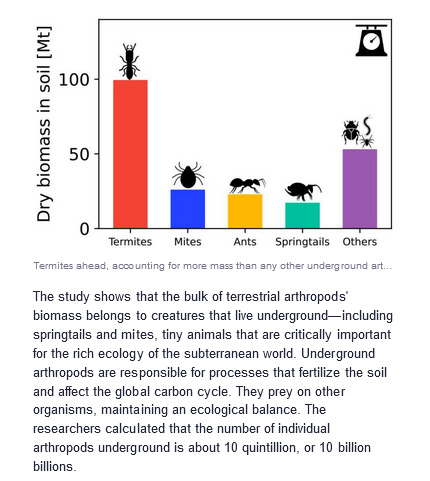


Arthropods crawl and buzz around us in the wild and on farmlands, on the street and at home, under our floors and in our plumbing systems, even in our food and on our bodies. [...] Yet, despite their crucial importance to the environment and humanity, and despite data suggesting a worrying decline in their numbers in areas impacted by human activity, scientists did not have holistic, global answers to basic questions about arthropods, such as how many of them are out there and how much they weigh collectively.
Researchers at the Weizmann Institute of Science have now taken a significant step toward answering these questions. In a study published today in Science Advances, a team headed by Prof. Ron Milo has calculated that the total biomass, or collective weight, of terrestrial arthropods is about 1 billion tons, which is roughly the same as that of all people (about 400 million tons) and all farm animals (about 600 million tons) combined. [...]
The researchers gathered data from thousands of observations conducted over the years at some 500 survey sites around the world. [...] The scientists examined data on arthropod biomass both below and above the ground, for example on plants. The study shows that the bulk of terrestrial arthropods' biomass belongs to creatures that live underground -- including springtails and mites, tiny animals that are critically important for the rich ecology of the subterranean world. Underground arthropods are responsible for processes that fertilize the soil and affect the global carbon cycle. They prey on other organisms, maintaining an ecological balance.
The researchers calculated that the number of individual arthropods underground is about 10 quintillion, or 10 billion billions.
Social insects that live in colonies account for half of the mass of underground arthropods: Termites and ants constitute 40 and 10 percent of that category, respectively. As for aboveground arthropods, most of their biomass is probably found in tropical forests, and it includes many familiar arthropods such as butterflies, ants, beetles, grasshoppers and spiders.
---
All content above, headline, images, graphics, captions, and text published by: Weizmnn Institute of Science. “The first global estimate of the combined weight of all land insects and related arthropods.” Phys dot org. 6 February 2023. [Bold emphasis and italicized first lines in this post added by me.]
The article itself:

190 notes
·
View notes
Text

Heavytails or piovela (Bebeleian) are small mammals characterized by their heavy sexual dimorphism and fluffy tails. This genus can be found on all continents, mostly in temperate grasslands and shrublands. Most species eat 'arthropods' and leaves, as well as berries and tubers, which is where they get their vivid pigments from (carotenoids and anthocyanins).
Their throat pouches are mostly used for long-distance communication, and are present in both sexes, but the males boast larger ones. During mating season, they increase blood flow to the area, inflate them with air, and croak in order to impress females, all while waving their eye-catching tails.
Something to note is that the male's tail isn't completely covered in fur, as it would be far too heavy; long, hollow, and dense fur grows on the sides of the tail, while the top and bottom are mostly sparse. In contrast, females have their entire tail covered in thick fur, as they use it to warm their young.
36 notes
·
View notes
Text
Pyrrhian Tribes and their Natural Prey
-While farming is common place in modern Pyrrhia and you can now buy food many dragons, particularly younger dragons and those who live away from the cities, still regularly hunt for their food
-IceWings primarily hunt seals, walrus, and whales. Polar bears, reindeer, and ox are also hunted but food wise come second to the marine prey and are more valuable for their pelts.
-SkyWings hunt mountain ungulates(deer, goats, sheep) supplemented by fish. Despite their name they don’t often go after birds with the exception of turkeys and other fowl in the lower forest areas of the kingdom.
-MudWings are opportunistic hunters and will take any animal large enough to qualify as a meal. Cattle, boar, crocodilians, and large aquatic rodents are frequently hunted.
-Like MudWings SeaWings also hunt anything in their environment big enough to qualify as a meal. Fish, sharks, large marine reptiles, squid, and whales (though less frequently than IceWings) are all part of a SeaWing’s diet.
-RainWings hunted monkeys, capybara, tapir, and occasionally large bugs. They purposefully avoided more dangerous prey like crocodiles or jaguars and instead fulfilled the rest of their dietary needs with fruits and nuts.
-SandWings take whatever they can get but primarily hunt giant arthropods, snakes, tortoises, and desert ungulates like pronghorns. On the edges of the Sand Kingdom where desert turns to grassland there is much larger prey that is hunted, but they are not in your typical SandWing diet.
-In the old kingdom NightWings hunted desert animals in addition to their own forest animals because of the proximity to the Sand Kingdom. Coyotes, deer, and even bears were hunted in the piney cliffs of the old kingdom.
#wings of fire#wof#wof headcanon#headcanon#pyrrhia#icewing#skywing#mudwing#seawing#rainwing#sandwing#nightwing
175 notes
·
View notes
Text


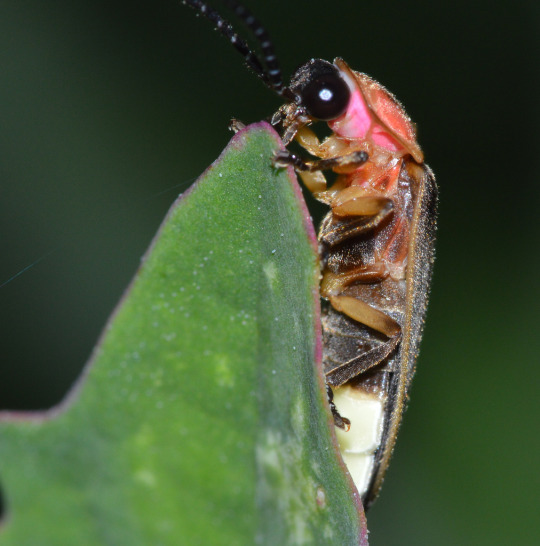
A Night Out with the Eastern Firefly
The eastern firefly, or North American firefly (Photinus pyralis), is a popular sight throughout the United States and southern Canada east of the Rocky Mountains. They are commonly associated with the beginning of summer, as they spend the winter hibernating underground and emerge only when the weather begins to warm. They are commonly seen in deciduous forests, grasslands, gardens, and backyards.
Contrary to their name, the eastern firefly is actually a type of beetle with well-developed wings. Adults are quite small, only 10-14 mm (0.39-0.55 in) long. They have a yellow and red head and a dark brown body with a narrow yellow stripe marking the outline of the wing casings. The main difference between the two sexes is the length of their wings; males have longer wings and are capable of flight, while females have shorter, less functional wings. Both sexes have a special organ on the end of their abdomens that produce light; however, the female's light tends to be weaker. The North American firefly produces its light by combining oxygen with a chemical called luciferin; the resulting chemical reaction gives off a glow which is amplified by special reflective cells in the firefly's abdomen.
Like all fireflies, P. pyralis uses its light producing ability to attract a mate. Males flash only while flying, in bursts about 6 seconds apart. Once a female signals her interest-- also by flashing-- the male lands near her and offers her a package called a spermatophore made of sperm, protein, and nutrients. If the female accepts, she inseminates herself and buries the rest of the package with her clutch of about 500 eggs. These eggs, which glow slightly during development, hatch about 4 weeks after being laid, and the larvae feed on the remains of the nutrient-rich spermatophore. The larvae can take one or two years to develop, and spend most of their time underground or near sources of fresh water like lakes and streams. Once the larva pupates and develops into an adult firefly, they only live in this stage for about a month before dying.
Both larva and adult eastern fireflies are predators, feeding on other insects like worms, snails, and other fireflies. However, larva spend almost all their time hunting for food, while adults spend the majority of their time seeking out a mate. To avoid predation, P. pyralis can emit foul-smelling odors and excretion of sticky substances; they also emit a chemical called lucibufagin that repells spiders. However, other species of fireflies will actually mimic the light patterns of the eastern firefly in order to predate upon them.
Conservation status: The North American firefly is currently considered Least Concern by the IUCN. However, they are threatened by light pollution, pesticides, and habitat loss.
Photos
Judy Gallagher
Katja Shultz
Sydney Penner via iNaturalist
#eastern firefly#north american firefly#Coleoptera#Lampyridae#rover fireflies#fireflies#beetles#insects#arthropods#deciduous forests#deciduous forest arthropods#grasslands#grassland arthropods#urban fauna#urban arthropods#animal facts#biology#zoology#ecology
135 notes
·
View notes
Text




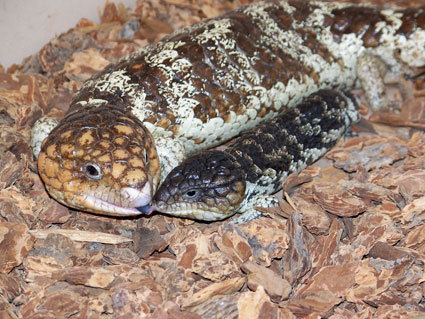
The Shingleback lizard also known as the Yoorn, the two-headed skink, the stumpy-tailed skink, the boggi, the pinecone lizard, and the sleepy lizard, is a species of skink found throughout the continent of Australia. Its 2lb, 12 inch long body is heavily armored and can be found in various colors, ranging from dark brown to cream. It has a short, wide, stumpy tail that resembles that acts as a false head to confuse potential predators. The tail also contains fat reserves, which are drawn upon during brumation in winter. A diurnal species, the shingleback can be found throughout arid forests, shrublands, grasslands, and desert environments where it feed upon snails, worms, arthropods, carrion, grasses, and flowers. Shinglebacks themselves are preyed upon by dingoes, pythons, birds of prey, foxes and cats. Unlike most lizards, Shinglebacks are social animals that form monogamous pairs that have been known to return to each other every year for up to 20 years. They breed from September through November. These lizards are viviparous, giving birth to broods of 1 to 4 relatively large offspring. The gestation period usually lasts around 5 months. The young are born well-developed and weigh about ¼ to 1/3 of a lb. The young are raised by there parents for 4-6 months before striking off on there won, but they remain in close proximity, forming and living in a colony of closely related skinks.
#pleistocene pride#pleistocene#pliestocene pride#pliestocene#cenozoic#ice age#stone age#lizard#australia#skink#pinecone#shingle back lizard#yoorn#boggi#shingleback#reptile
7 notes
·
View notes
Text
Hello everyone! Damn, the paddlefish article has really brought a lot of new folks to this blog! Welcome everyone, and thank you so much for joining this lovely little project of mine--I am so grateful that so many people have taken an interest in my work and in the species I want to help protect.
Since there are so many new folks here, I wanted to give a brief rundown on the articles I've written so far. In the last year and a half of this project, I've been able to write about seventeen awesome and unique species that are in need of further conservation attention. Here are some links to learn more about them:
Olm (Proteus anguinus): the OG and mascot for the site, this eyeless salamander manages to survive in its pitch-dark cave biome through incredible sensory abilities and supernatural patience.
Indian Purple Frog (Nasikabatrachus sahyadrensis): this comically-ugly creature is also incredibly mysterious, spending its entire life underground and only emerging for a single day each year.
Pygmy Hippo (Choeropsis liberiensis): this secretive, pig-sized mammal is the only surviving relative of the mighty river hippo, but lives a completely different lifestyle from its much more famous cousin.
Scaly-Foot Snail (Chrysomallon squamiferum): one of the weirdest animals on the planet, this snail grows a shell reinforced with iron and lives around hydrothermal vents deep beneath the surface of the Indian ocean.
Kaua'i Cave Wolf Spider (Adelocosa anops): this blind cave spider is one of the rarest arthropods on Earth, and lives in tunnels carved by lava flows beneath the surface of the Hawaiian Island of Kaua'i.
Shoebill (Balaeniceps rex): this huge African water bird uses its tremendous beak like a guillotine to smash and decapitate its prey.
Largetooth Sawfish (Pristis pristis): this relative of sharks and rays has a tremendous nose lined with teeth which it uses to dig up and swipe at prey, but that's not the only thing its nose is good for.
Takin (Budorcas taxicolor): this large goat relative is quite possibly the most mysterious large land mammal on Earth, as it lives deep in the forested mountains of China, India, and Bhutan.
Zacatuche (Romerolagus diazi): also known as the "volcano rabbit", this adorable little fellow is an excellent gateway into understanding the benefits of grasslands to ecosystems and human settlements alike. Done in collaboration with Mexico'a CONANP.
(tambien en español)
Secretarybird (Sagittarius serpentarius): this badass raptor stalks the African savannah, using its powerful legs to deliver one of the fastest and most accurate kicks in the animal kingdom (and yes it's also the bird from Aggretsuko).
Manchineel (Hippomane mancinella): the first plant written about on Consider Nature (though certainly not the last), the manchineel is quite possibly the most toxic tree in the world, with every part of its anatomy steeped with a variety of noxious substances.
Gharial (Gavialis gangeticus): this crocodilian is a fish specialist, using its long, slender snout like a rapier to cut through the water and snag its prey.
Vaquita (Phocoena sinus): the most-endangered mammal on the face of the Earth, the Vaquita is a tiny porpoise that has gotten caught up in the black market trade of an extremely valuable fish bladder. Done in collaboration with Sea Shepherd International.
Pekapeka (Mystacina tuberculata): this tiny bat species is one of only 2 mammals native to New Zealand and spends more time on the ground than any other bat species in the world, despite being able to fly.
Angular Roughshark (Oxynotus centrina): this shark is native to the coasts of Western Europe and Africa, where it lives over a thousand feet beneath the waves and is rarely seen by people.
Marine Iguana (Amblyrhynchus cristatus): these iguanas are the only seafaring lizards in the world, and have developed a variety of remarkable adaptations to survive the extreme conditions of the Galapagos Islands.
And as always, if you have any suggestions, questions, or just want to say hi, you can DM me here or email me at [email protected]. Welcome, and thank you for your support.
4 notes
·
View notes
Text
TIDBITS (mostly about arthropods)
These creatures, for starters, are very different from their real life counterparts behaviour wise and appearance wise in my headcanon. They are not actually insects/arthropods on the planet of Minecraft but rather descendants of native alien beings so I will refer to them as pseudoinsects.
Silverfish fill the same niche as rats and mice. They puff up with sharp nasty barbed quills when threatened and have an irritating bite. They are not related to or resemble real world silverfish in any way, as they are not aquatic, and, like many other minecraftian pseudoinsects, are not traditionally insectoid. They are able to squeeze into tiny crevices to lay their eggs and eat an assortment of items such as moss, smaller pseudoinsects and bats.
Spiders fill the same niche as medium sized predators like lynxes, wolves and coyotes, while wolves reign apex predator in wooded areas, spiders have domain over open grasslands. Unlike the smaller cave spiders their venom is not as potent and they use their mandibles to slice and gnaw their prey’s weak points (throat, belly, face, Achilles heel to immobilize them)
Bees are completely different from their earth counterparts, apart from their size, they have a more mammalian family structure and are not in hives.
Cave spiders are smaller and less aggressive but have a nasty poisonous bite which can cause excruciating inflammation and nausea. They typically are not lethal though especially if the bite is inflicted by a juvenile. They form nests in abandoned mineshafts due to their lack of subterranean predators that could prey on their young, and the ample source of bats and silverfish to prey on.
Endermites lay grubs in chorus fruit and latch onto and feed off of Endermen. Endermen, when they are able to pry these unpleasant creatures off, may feed on them for a rare opportunity to consume protein in their desolate environment. Endermites resemble ticks, being plump, semi translucent and bulbous with tiny legs and a singular red eye.
42 notes
·
View notes
Photo

Common Scaly-Foot (Pygopus lepidopodus)
Family: Flap-Foot Family (Pygopodidae)
IUCN Conservation Status: Least Concern
Although its long and seemingly limbless body means that it is easily mistaken for a snake, the Common Scaly-Foot is, surprisingly, actually a member of a family of highly specialized geckos known as Pygopodids or flap-foots that have independently developed snake-like bodyplans to allow for more efficient movement through dense vegetation and subterranean burrows (while they have lost their front limbs entirely, many Pygopodids retain tiny, flap-like hindlegs which are theorized to serve some role in courtship, and this combined with their external earholes and thick, unforked tongues can be used to distinguish them from snakes upon close inspection.) Native to southern and eastern regions of Australia, the Common Scaly-Foot inhabits dense grasslands, heathlands and woodlands and is among the most abundant and extensively studied members of its family. It is active mainly at dawn and dusk (although may become entirely nocturnal during periods of extremely warm weather,) feeds mainly on small arthropods (particularly burrowing spiders, easily navigating their dens with its long and flexible body), and, like almost all geckos, reproduces by laying eggs which are laid underground in small clutches. When threatened, members of this species have been observed to take advantage of their snake-like appearance by rearing up and opening their mouths in a manner that resembles the defensive threat displays of some venomous snakes (although, as Common Scaly-Foots are not venomous and lack any real defensive abilities besides mimicry, this threat is ultimately empty.)
--------------------------------------------------------------------------
Image Source: https://www.inaturalist.org/taxa/36963-Pygopus-lepidopodus
#Common Scaly-Foot#gecko#geckoes#lizard#lizards#reptile#reptiles#animal#animals#zoology#biology#herpetofauna#Herpetology#Australian wildlife
167 notes
·
View notes
Text
December 23rd, 2023
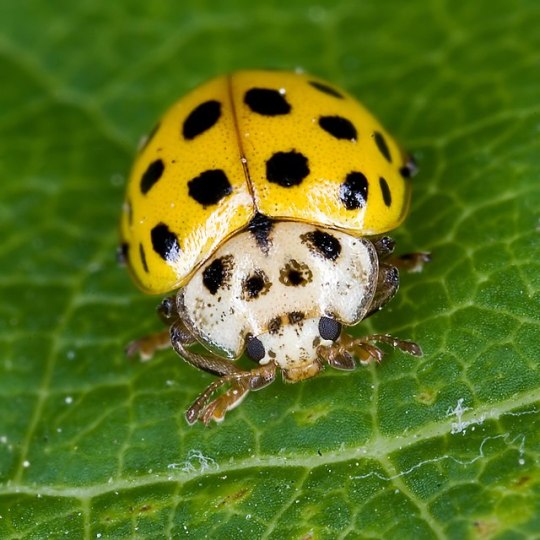

22-Spot Ladybird (Psyllobora vigintiduopunctata)
Distribution: Found in disjointed populations throughout Europe; most common in the northern half of Europe, including the Czech and Slovak Republics, Germany, Belgium, the Netherlands, Scandinavia and the U.K. Has also been reported in the United States, but populations do not seem to have spread significantly.
Habitat: Prefers open habitats, such as forest borders, grasslands, parklands, wastelands and roadsides.
Diet: Fungivore; feeds primarily on the mildews and molds, especially on low-growing shrubs and plants of the Apiaceae family. Commonly found on hogweed, ragwort, creeping thistle, oak and birch.
Description: 22-spot ladybirds are fairly unique among ladybugs due to their fungivorous diet; most ladybugs are carnivorous, feeding on small arthropods like aphids, small spiders, mites and mealy bugs. These insects mainly graze on powdery mildew, a pathogenic fungus that infects plant leaves, causing ailments such as molding and rusts. Though it feeds on a common pathogen, these insects have little use as biological control agents, as they will inoculate new leaves by spreading spores.
A common myth about this insect states that the number of spots it has reflects its age, but this is unfortunately false. The number of spots varies between individuals, but does not vary between years—you'd have a lot of trouble finding a 22-year old ladybug!
Images by Olaf Leillinger (adult) and Gilles San Martin (larva).
17 notes
·
View notes